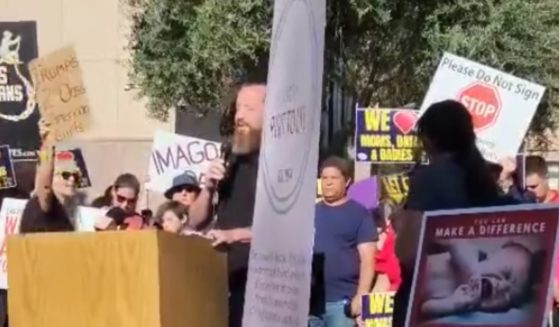Narrative Immunity: White House Insider Reveals Trump Vaccine Prioritization Saved the Day
When life felt normal before the outbreak of COVID-19, a series of providential events unfolded within the White House.
Officials in the Trump administration could not know what was looming on the horizon, but their quick work helped contribute to the rapid development of safe and effective coronavirus vaccines.
Now, Casey Mulligan, former chief economist on the Council of Economic Advisers during 2018 and 2019, is illuminating how a set of executive initiatives put the United States in a position to overcome the pandemic.
In Defense of Prudence
“The same general lesson for the economy applies very well in health,” Mulligan said in a recent interview with The Western Journal.
Innovation, “as opposed to nitpicking and quibbling,” has spurred advances in surgical procedures, medical equipment, treatments for heart disease and uses for pharmaceuticals, he added.
Under that premise, a 2019 Council of Economic Advisers report postulated that vaccine innovation would be the most effective way to diminish losses in a major pandemic.
Building on the Trump administration’s success in lowering prescription drug prices, the team of Chicago-school economists advocated for a string of proposals that focused on investing in new methods for vaccine production, manufacturing and distribution.
“Improving the speed of vaccine production and vaccine efficacy are both important goals to mitigate pandemic risks and may also decrease the costs of seasonal influenza,” the economic advisers reported.
“Large-scale, immediate immunization is the most effective way to control the spread of influenza, but the predominant, currently licensed, vaccine manufacturing technology would not provide sufficient doses rapidly enough to mitigate a pandemic.”
The counsel’s report gained traction in the White House, resulting in the enactment of Executive Order 13387 on Sept. 19, 2019.
The order allocated funds and directed resources “to expand domestic capacity of alternative methods that allow more agile and rapid responses to emerging influenza viruses” and “advance the development of new, broadly protective vaccine candidates that provide more effective and longer lasting immunities.”
And Mulligan argues the decision to invest early was a wise one.
No Time to Waste
During a pandemic, he noted, “we don’t have time to waste.”
“Even if we have the luxury of wasting the consumers’ money, we don’t have the luxury during a pandemic of wasting their time.”
Trump’s order altered the traditional processes of bureaucratic oversight and compliance by speeding up the rate at which new medical technologies could be officially approved.
“The normal way of approaching approvals for vaccines, or treatments or drugs during a pandemic is not how you should proceed,” Mulligan said.
“You should be concerned for safety, but not as concerned. Speed is more important because if you get something that you’re really happy that it’s safe, but it takes you three years — it’s all over by then. It was pointless.”
Before the COVID-19 pandemic hit the United States, Trump’s team had already determined that the Food and Drug Administration would have less than a year to develop and distribute a safe and effective vaccine.
The push for rapid vaccine procurement was successful. According to the National Institutes of Health, Moderna tested its vaccine on humans for the first time on March 16, 2020, only three months after the initial spread of the virus outside China.
And on March 11, 2020, the World Health Organization classified COVID-19 as a pandemic — five days before the first trial.
According to government documents, the Trump administration formed Operation Warp Speed in May, investing $10 billion to “rapidly develop, produce, and distribute multiple safe and effective vaccines to protect lives and restore livelihoods by accelerating the end of the pandemic.”
In hindsight, it’s clear that certain mitigation efforts worked while other efforts failed. Of the many measures put in place to slow the spread of the disease and alleviate economic distress, none have proved more effective than the vaccine.
“It was held to a different standard,” Mulligan said.
While the government can contemplate for over a year about a vaccine’s safety and effectiveness, “they don’t have to contemplate for three seconds before the public has to experience all these kinds of closures,” he argued.
“It’ll be plain as day to everyone in a few months that vaccines got us out of this — not a lockdown, not a shut school,” he said.
“Nobody is going to be able to deny that the vaccine is the elephant in the room and everything else is trivial.”
A recent report from the Centers for Disease Control and Prevention vindicates Mulligan’s claims and Trump’s actions.
A Return to ‘Normalcy’
On Jan. 8, the United States reported its highest surge in new COVID-19 cases, in addition to recording approximately 3,700 new deaths.
In an interview that week on C-SPAN, Dr. Anthony Fauci, the nation’s top infectious disease expert, warned Americans that in upcoming months the nation would endure more death, suffering and misfortune.
“We’re going now between [$2,000] and 3,000 deaths per day,” Fauci said, “so if you just do the math on that — and say you know, three months from now or close to 100 days from now — that’s another 3,000 times 100.
“That’s a lot of deaths.”
By April 16, Fauci estimated that roughly 300,000 more Americans would die from COVID-19 and countless others would be infected with the virulent disease — a seemingly somber return to the days of last March and April.
For the past nine weeks, however, COVID-19 cases have dropped steadily. In fact, new cases have decreased by about 79 percent compared to that perilous week in early January, according to the CDC’s COVID data tracker.
Now in mid-March, medical authorities are measuring a 3-percent “decrease in the 7-day average number of daily cases reported compared with the prior week, which provides an encouraging sign of continued progress.”
Approximately 16 percent of Americans have received both doses of the coronavirus vaccine, while more than a quarter of the population has received at least one dose, according to the CDC.
As Americans are getting vaccinated, infection rates and death rates continue to plummet. Society is now slowly returning to a state of normality.
That ubiquitous feeling of confusion and distress, which engulfed nearly every facet of the imagination last year, is fading away. At this juncture, the emergency response in the United States has concluded.
Trump’s prudent directives, and those early reports from the CEA, played an instrumental role in spurring the innovation necessary to get the United States out of its war with the virus.
Truth and Accuracy
We are committed to truth and accuracy in all of our journalism. Read our editorial standards.












